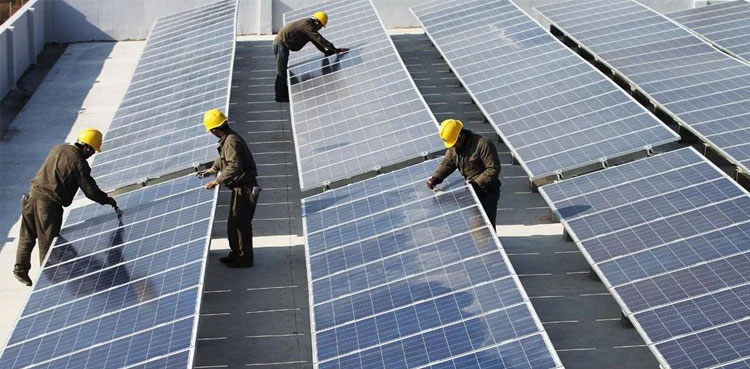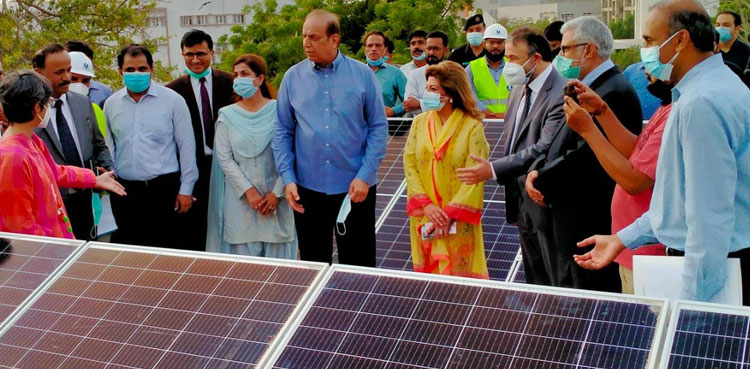Need for solar energy
- By Uzair Ali -
- Jun 08, 2023

Not only that Pakistan suffers from acute energy deficit but its costs have exorbitantly increased making it difficult for even reasonably affluent to foot the bills. Instead of witnessing any improvement in the current state of affairs, it has been more than two decades that the country started facing electricity blackouts is still experiencing them underlining the fact there is something inherently flawed with the perceptive and structural aspects of energy provision that result in almost permanent imbalances in this crucial sector.
The need for addressing this crucial issue is imperative and cannot be delayed anymore. The pressures exerted by the acute loss of energy have deeply debilitated the economy of Pakistan with severe consequences for the country and its people.
The most worrying aspect is that despite being located in a region severely affected by climate change, Pakistan continues to invest in environmentally unfriendly methods of power production and not only that but there is a sustained adherence to extremely costly electricity-producing products that have put the entire sector under duress.
Viewed in the backdrop of the current reliance on generating electricity through expensive methods that are officially supported, Pakistan’s policy makers are consistently avoiding taking decisions to look for alternate methods of procuring energy.
The inertia of the political and professional centres is astonishing speaking volumes about the prevalent inefficiency in the system.
Despite a consensus that Pakistan possesses reasonably good potential for generating electricity through solar power as it is well-known that the region in which it is situated are consistently dry basking in blinding sunlight yet the policy makers consistently neglect it.
It is widely known that credible researches conducted by institutions such as the World Bank have indicated that Pakistan can potentially generate 92% of its electricity requirements from solar energy and that too by utilising just 0.071% of the country’s area for solar photovoltaic (PV) power generation that would meet the current demand.

Though the policy makers consistently announce that they plan shifting over to alternative methods of electricity production assuring the people that the country would be able to produce 60% of its electricity from renewable sources by 2030 but practically they have failed to deliver on their assertions.
This would require Pakistan to install around 24,000 megawatts of solar and wind power capacity by 2030, up from just over 1,500 megawatts now. Many experts maintain that Pakistan could conceivably generate more than 2,900 gigawatts of solar power capacity.
It is also stressed by them that solar power would be cheaper than hydroelectric power and claim that a $10 billion investment in solar power could generate 50 to 60 gigawatts of capacity that would represent ten times more than what is produced from the Tarbela and Mangla dams.
Despite huge potential, the country is hopelessly slow to take advantage as it is estimated that at 530 MW, solar constitutes less than two per cent of the total installed electricity generation capacity with this supply remaining practically stagnant. All solar power projects are small-scale with individual installed capacities of 100 MW or less.
The question however arises is that what is holding the development of solar energy in the country and the answers are usually a confusing mix.
To begin with is the coal lobby that claims lower production costs while ensuring consistent supply for quite a long time and also generates employment though it is very environment unfriendly but this factor does not matter much in the country.
Then there are arguments about complications in finding space for solar farms, procedural delays in construction approvals and unattractive tariffs for selling power to national grid. Moreover, the high costs of initial investment is hampering the growth of solar power, even if diversifying energy sources makes economic sense in the long run.
Many experts however disagree with this policy and warn that solar technology runs the risk of increasing Pakistan’s dependence on technology owned by the US and China. In addition, solar panels occupy much space if installed on a massive scale that could be potentially harmful for the county’s agriculture, exacerbating food insecurity.

They also point out that Pakistan has invested billions of dollars in hydro and thermal plants as many could work for years and in this context it would be a folly to scrap the and make way for solar energy. While the official reluctance about so lar energy goes on, the private sector is resorting to it in a big way as it can visualise in it the potential of generating 4,000 MW to 4,500 MW.
The other attractive feature of it is its low cost of production as the average cost is estimated at Rs.11 per unit including the cost of batteries as compared to the current Rs.40+ per unit of electricity.
In this context, it is prudent for homeowners to switch to a hybrid solution of on-grid and solar power as the sun powering the household when it shines and grid electricity steps in when it does not such as in cloudy weather and at night.
Many households have reported drastic reduction in their electricity costs and have also managed to substantially recoup their initial investment One crucial difficulty in this respect is that procuring solar energy is not within the budget resources of the majority in the country.
It costs about Rs.150,000 per KW (roughly Rs.150 per watt), with installations coming in at multiples of 5 KW. Battery storage adds a further Rs.250,000 per KW for a home provision.
To make it more unaffordable Pakistan has taxed this sector at 17 per cent virtually derailing the sector. Financing is another challenge though the State Bank of Pakistan (SBP) has provided a renewable energy financing facility to encourage banks to increase their green financing portfolios with a maximum annual mark-up rate of six per cent.
This financial initiative has actually encouraged the increase the solar market though the hitch is that this particular financing facility would come to an end by the end of the current financial year and it is yet to be seen if it is extended or otherwise.
Another rather tedious difficulty is that solar, or any other form of renewable energy, will not solve the current transmission challenges.
The main weakness lies in the distribution system and solar energy would have to rely on this outdated infrastructure for distribution.
The underlying idea in this respect is to empower the individual households by moving away from the battered traditional transmission system and encouraging the consumer to produce energy for its own use and also to distribute it to the other through centralised grid stations.
This will also enable the state transmission networks to avoid making huge investment in transmitting electricity from its source of generation. It is now known that a huge acreage of land is being employed for the purpose particularly in areas where grid is also available where photovoltaic technologies are deployed for on-grid power generation project.
Grid tied power projects of various capacities are installed in various parts of the country. A total of six utility scale solar PV power projects having cumulative capacity of 430 MW are operational and supplying electricity to National grid.
Further, four solar PV power projects with cumulative capacity of 250 MW are under construction and many more solar PV power projects are in pipeline.
